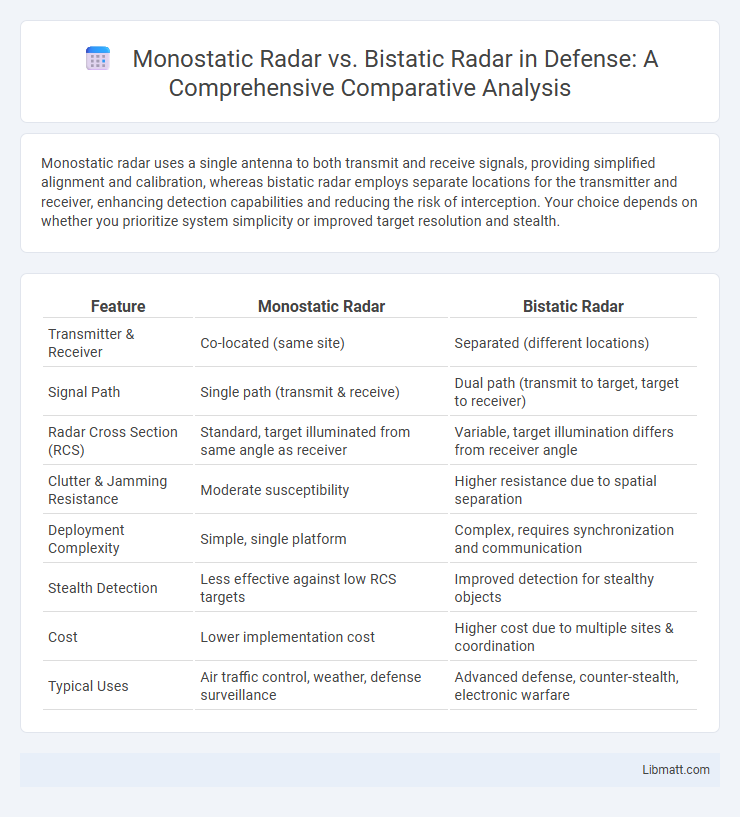Monostatic radar uses a single antenna to both transmit and receive signals, providing simplified alignment and calibration, whereas bistatic radar employs separate locations for the transmitter and receiver, enhancing detection capabilities and reducing the risk of interception. Your choice depends on whether you prioritize system simplicity or improved target resolution and stealth.
Table of Comparison
| Feature | Monostatic Radar | Bistatic Radar |
|---|---|---|
| Transmitter & Receiver | Co-located (same site) | Separated (different locations) |
| Signal Path | Single path (transmit & receive) | Dual path (transmit to target, target to receiver) |
| Radar Cross Section (RCS) | Standard, target illuminated from same angle as receiver | Variable, target illumination differs from receiver angle |
| Clutter & Jamming Resistance | Moderate susceptibility | Higher resistance due to spatial separation |
| Deployment Complexity | Simple, single platform | Complex, requires synchronization and communication |
| Stealth Detection | Less effective against low RCS targets | Improved detection for stealthy objects |
| Cost | Lower implementation cost | Higher cost due to multiple sites & coordination |
| Typical Uses | Air traffic control, weather, defense surveillance | Advanced defense, counter-stealth, electronic warfare |
Introduction to Monostatic and Bistatic Radar
Monostatic radar uses a single antenna for both transmitting and receiving signals, allowing efficient target detection and ranging with integrated hardware. Bistatic radar involves separate locations for transmitter and receiver, enhancing detection capabilities against stealth targets and providing spatial diversity. Your choice between these radar systems depends on operational requirements such as coverage area, target type, and environmental conditions.
Fundamental Principles of Radar Systems
Monostatic radar operates with the transmitter and receiver co-located, emitting signals and detecting reflected echoes from targets to measure range and velocity based on time delay and Doppler shift. Bistatic radar separates the transmitter and receiver spatially, enabling the detection of targets by analyzing the difference in signal paths and leveraging angular bistatic geometry to enhance target resolution and counter stealth. Fundamental principles involve electromagnetic wave propagation, signal reflection, and time-of-flight measurement, with bistatic radar offering increased complexity in signal processing but advantages in stealth detection and interference mitigation.
Monostatic Radar: Structure and Operation
Monostatic radar consists of a single antenna system used for both transmitting and receiving signals, enabling synchronized operation for detecting targets. The transmitter emits radio waves that reflect off objects and return to the same antenna, where the echo is processed to determine the target's range, velocity, and angle. This radar configuration simplifies signal processing and hardware design but can be limited by line-of-sight constraints and susceptibility to certain countermeasures.
Bistatic Radar: Configuration and Functionality
Bistatic radar consists of separate transmitter and receiver locations, positioned at different points to detect targets by analyzing the scattered signals. This spatial separation enhances target detection capabilities by reducing the radar cross-section and improving stealth detection. Understanding bistatic radar's configuration enables you to leverage its functionality for complex surveillance and reconnaissance tasks.
Signal Processing in Monostatic vs Bistatic Radar
Monostatic radar processes signals using a single antenna for both transmission and reception, simplifying synchronization and allowing coherent processing of the returned echoes. Bistatic radar requires advanced signal processing techniques to handle different transmission and reception locations, managing complex time delays, angles, and Doppler shifts. Your radar system's performance depends heavily on these processing methods to accurately detect and track targets in each configuration.
Detection Range and Coverage Comparison
Monostatic radar typically offers longer detection ranges due to the co-location of the transmitter and receiver, which minimizes signal losses and maximizes power efficiency. Bistatic radar enhances coverage by spatially separating the transmitter and receiver, allowing for greater area surveillance and improved detection of stealth objects from multiple angles. Your choice between these systems depends on whether extended range or broader area coverage aligns best with mission requirements.
Advantages of Monostatic Radar Systems
Monostatic radar systems offer the advantage of simpler design and installation since the transmitter and receiver share the same location, reducing infrastructure complexity and cost. They provide more straightforward signal processing and synchronization, enhancing detection reliability and accuracy. Your radar setup benefits from compactness and ease of maintenance, making monostatic radars ideal for many military and civilian applications.
Benefits and Challenges of Bistatic Radar
Bistatic radar offers increased detection capabilities by using separate transmitter and receiver locations, enhancing target resolution and reducing susceptibility to electronic countermeasures. The spatial separation allows for improved stealth detection and lower vulnerability to jamming, benefiting surveillance and defense systems. However, bistatic radar faces challenges in synchronization, signal processing complexity, and precise geometric calibration, requiring advanced technology to optimize its performance for your radar applications.
Key Applications in Modern Technology
Monostatic radar is widely used in air traffic control, weather monitoring, and defense systems due to its simplicity and ability to provide accurate target detection from a single location. Bistatic radar excels in stealth detection, missile guidance, and surveillance where spatial separation between transmitter and receiver enhances detection capabilities and reduces signal interception risks. Your choice between monostatic and bistatic radar depends on specific application needs such as range, coverage, and operational environment.
Future Trends in Radar System Development
Monostatic radar systems are evolving with enhanced signal processing and artificial intelligence integration to improve target detection and clutter rejection. Bistatic radar technology is gaining traction due to its advantages in stealth detection and resilience against electronic countermeasures, leveraging spatial separation between transmitter and receiver. Your choice of radar architecture will influence system adaptability to emerging threats and integration with multisensor networks in future defense applications.
monostatic radar vs bistatic radar Infographic

 libmatt.com
libmatt.com